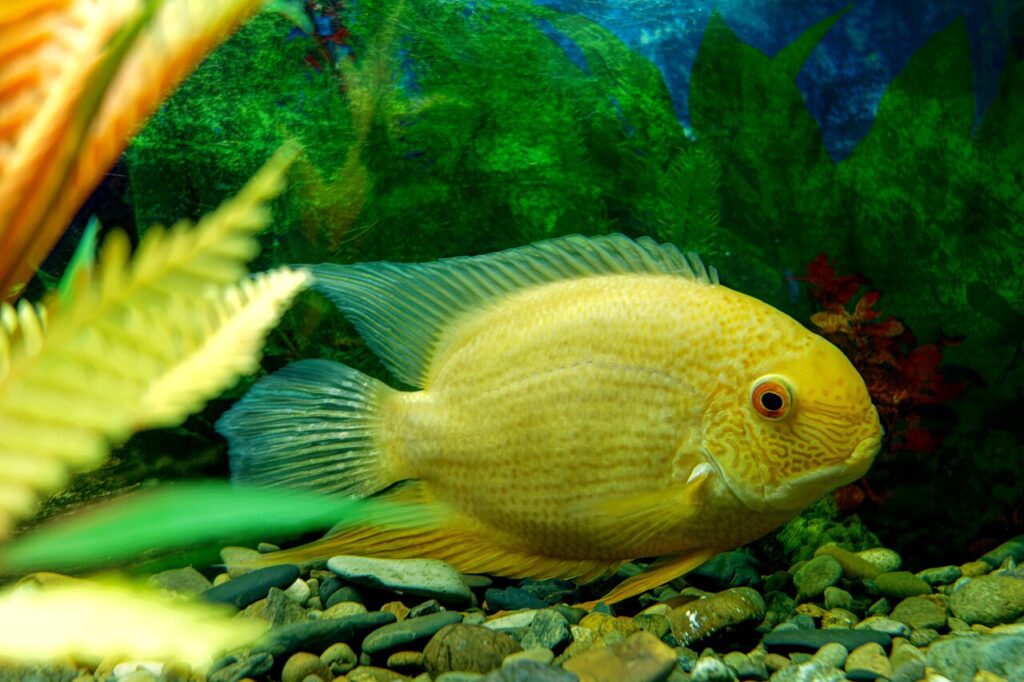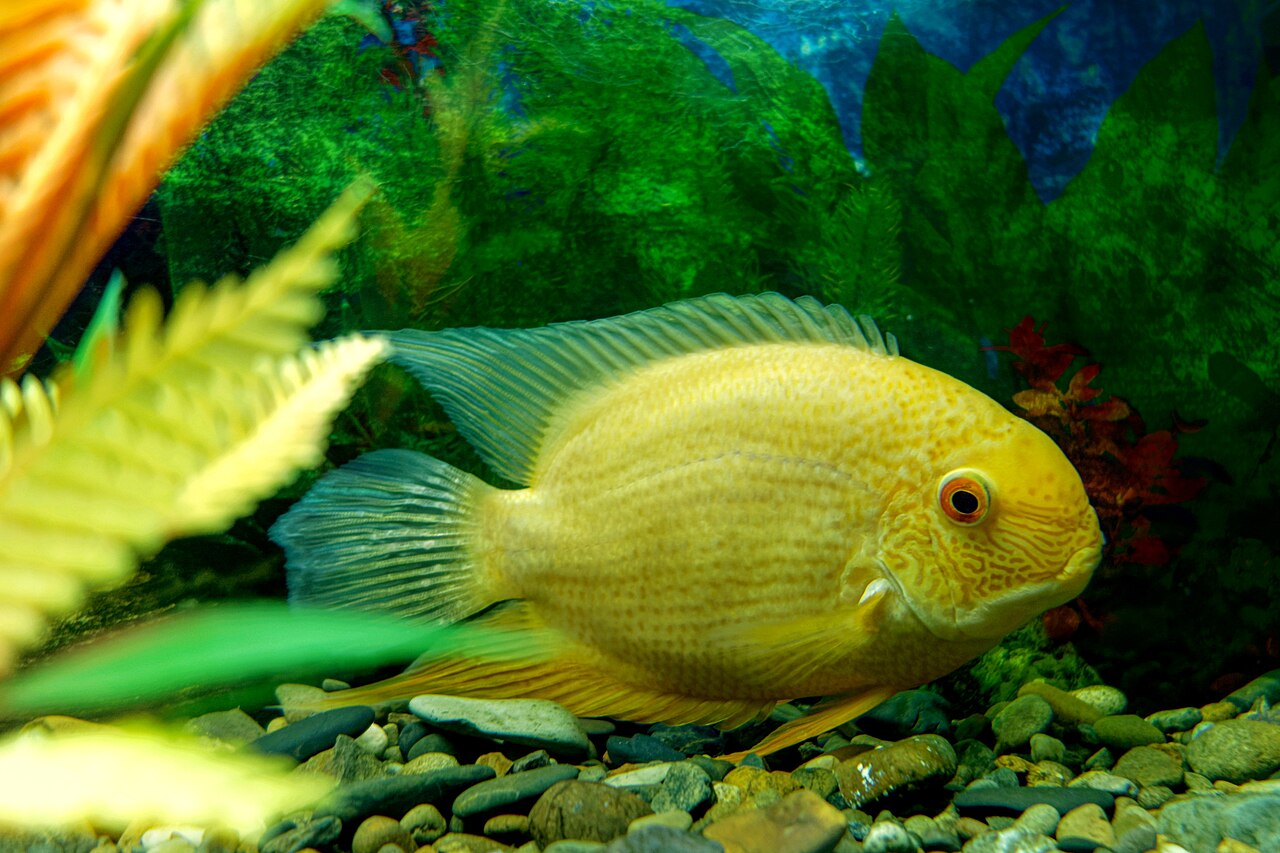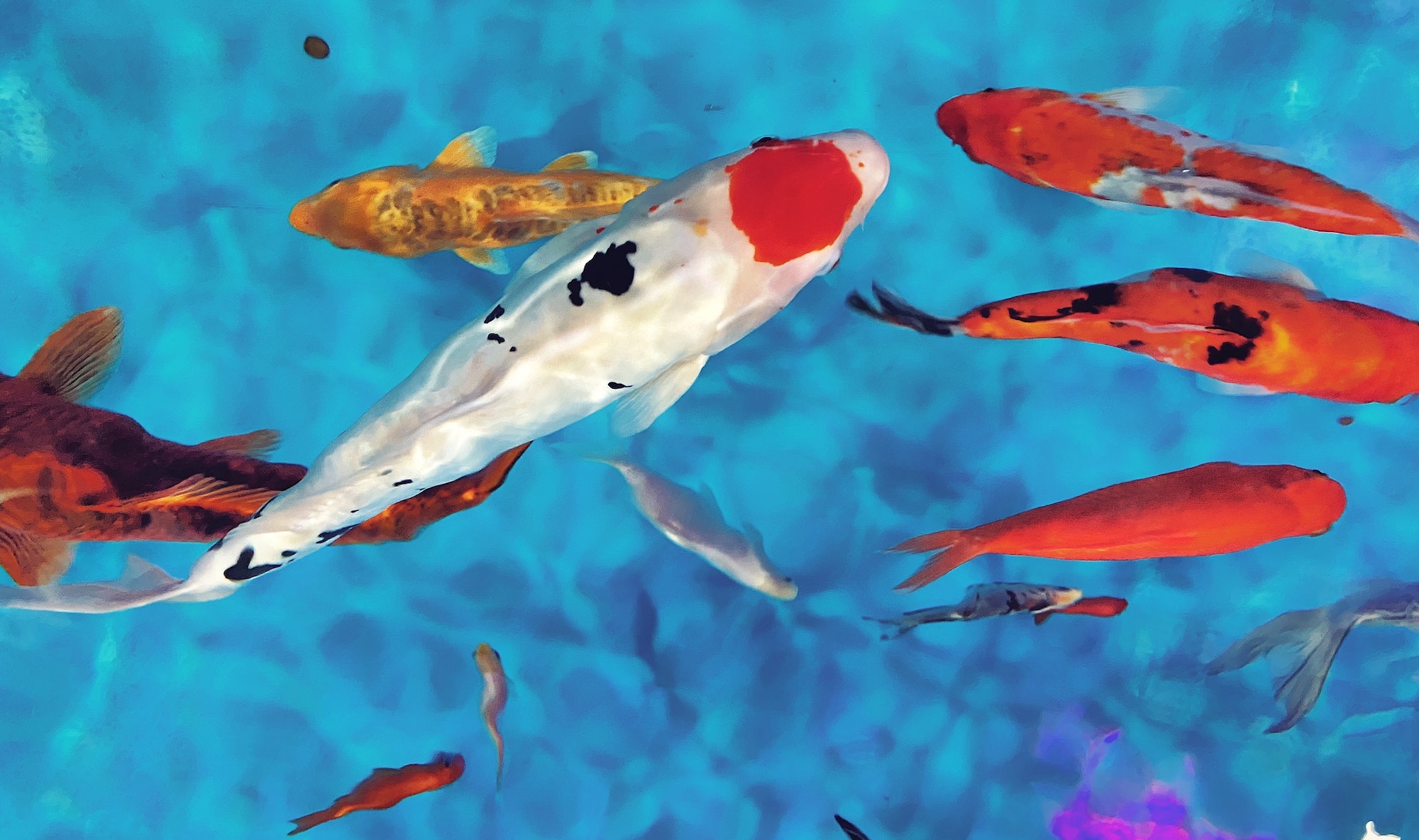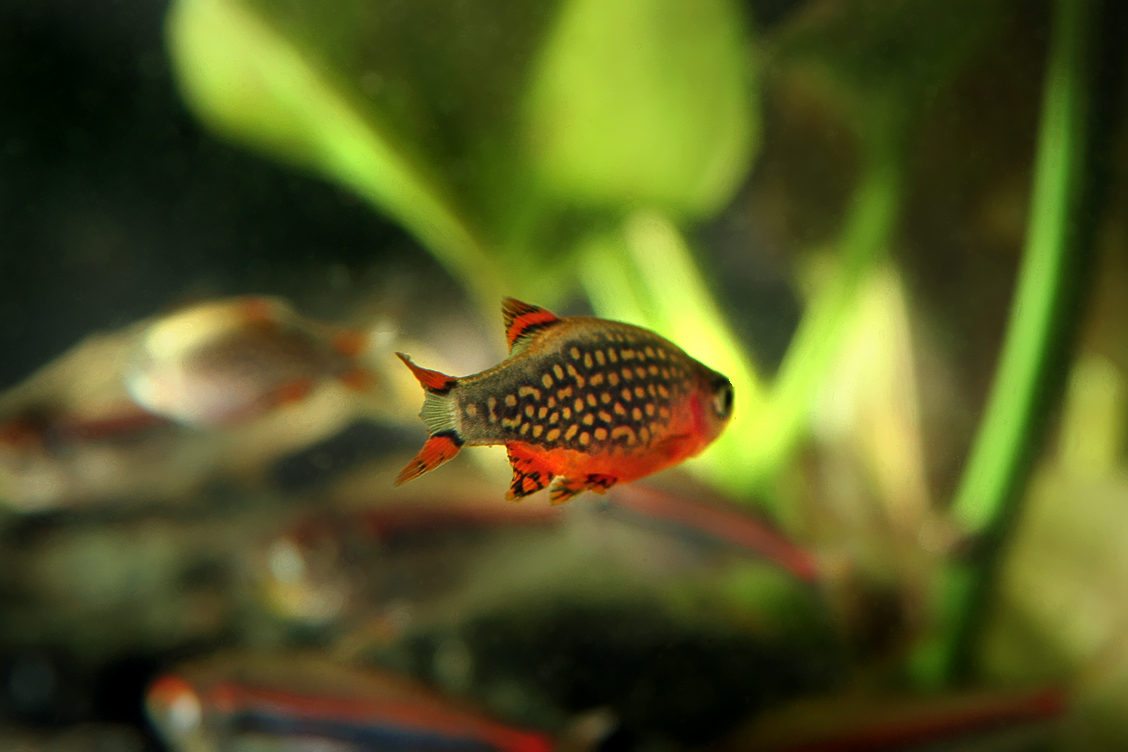The Severum Cichlid, scientifically known as Heros efasciatus, belongs to the diverse Cichlidae family. Originating from the slow-moving waters of the Amazon basin, these fish are not a rarity in the aquarium trade. Revered for their varied colors and peaceful nature, they make an excellent choice for aquarists of all levels.
Table of Contents
Delving into their history, Severum Cichlids have been part of the aquarium scene for many years, captivating enthusiasts with their striking appearance and intriguing behaviors. First described in the 19th century, these fish have since been bred selectively, resulting in a spectrum of color variants.
Speaking of colors, the most popular variants include the Green Severum, showcasing a natural greenish pattern, the Gold Severum with its luminous gold hue, and the Red Severum, selectively bred for its vibrant red coloration. These variants add a splash of color and liveliness to any aquarium.
In terms of their habitat preferences, Severum Cichlids are primarily mid-dwellers in the aquarium. They thrive in environments that mimic their natural habitat, requiring a spacious tank with ample hiding spots. Their diet is omnivorous, encompassing both plant and animal matter. When it comes to their behavior and temperament, they are generally peaceful but can exhibit territorial tendencies, particularly during breeding.
From a statistical perspective, Severum Cichlids can reach up to 8 inches in length and, with proper care, live up to 10 years. They are known for their parental care, with both parents actively guarding and caring for their eggs and fry. This aspect of their behavior is not only fascinating but also indicative of their social nature.
In terms of compatibility, Severum Cichlids do well with other non-aggressive fish, making them suitable for community tanks. However, their tank mates should be chosen carefully to ensure a harmonious environment.
In conclusion, the Severum Cichlid, with its varied colors, peaceful demeanor, and interesting history, is a delightful addition to any freshwater aquarium. Whether you are a seasoned aquarist or new to the hobby, these fish offer a unique combination of beauty and intriguing behavior that can enhance your aquatic experience.

Key Information
Severum Cichlids, known for their striking appearance and adaptable nature, come in various captivating variants. The most popular among them include the Green, Gold, and Red Severum, each offering unique aesthetic appeal. These variants not only differ in color but also slightly in their behavior and care requirements, making the Severum Cichlid a versatile choice for aquarists seeking diversity in their tanks.
| Family | Cichlidae |
| Price | Varies depending on variant and size; generally moderate to high priced in the aquarium trade |
| Common Names | Severum, Banded Cichlid |
| Variants | Green Severum, Gold Severum, Red Severum |
| Ideal Tank Size | Minimum 55 gallons; larger is preferable for adult fish |
| Water Parameters | pH 6.0 – 7.5, Temperature 75-84°F (24-29°C) |
| Lifespan | Up to 10 years with proper care |
| Full Size | Up to 8 inches (20 cm) in length |
| Natural Environment | Slow-moving or standing waters of the Amazon River basin |
| Behavior | Generally peaceful, can be territorial, especially during breeding |
| Habitat Preference | Mid-water levels, prefers areas with cover |
| Aquarium Decoration | Rocks, driftwood, and plants for hiding places; open swimming areas |
| Ideal Tank Mates | Other peaceful fish of similar size; some larger tetras, angelfish, catfish, and loaches |
| Fish to Avoid | Aggressive species or those small enough to be considered prey |
| Best Foods/Diet | Omnivorous – variety of plant and animal matter, including pellets, flakes, and live/frozen foods |
| Disease | Susceptible to common freshwater fish diseases; proper tank maintenance is crucial |
| Sex-switch | No known ability to switch sex |
| Gender Differences | Males are often larger and more colorful; females may have a plumper body shape |
| Care Level | Moderate; suitable for aquarists with some experience |
| Breeding Level | Moderate; known for parental care, breeding can be achieved in a well-maintained aquarium |
Ideal Tank Mates
Severum Cichlids, known for their generally peaceful demeanor, can be great additions to a community tank if paired with compatible species. The key to selecting ideal tank mates for Severum Cichlids lies in choosing fish that are peaceful or semi-aggressive, similar in size, and have comparable water parameter requirements. Here are 15 ideal tank mates for Severum Cichlids, each chosen for their compatibility in terms of behavior, size, and environmental needs.
Angelfish (Pterophyllum sp.)
Angelfish are a popular choice for sharing a tank with Severum Cichlids. Both species prefer similar water conditions and are relatively peaceful. However, care should be taken during breeding as both can become territorial.
Silver Dollar (Metynnis argenteus)
Silver Dollars are known for their peaceful nature and similar size, making them good companions for Severum Cichlids. They are also fast swimmers, which helps them avoid any potential territorial disputes.
Bristlenose Pleco (Ancistrus sp.)
Bristlenose Plecos are excellent choices due to their bottom-dwelling habit and peaceful nature. They help keep the tank clean by eating algae and do not compete for the same space as Severum Cichlids.
Pearl Gourami (Trichopodus leerii)
Pearl Gouramis are peaceful and can coexist with Severums without any issues. Their calm demeanor and preference for the middle to top levels of the tank make them compatible.
Bolivian Ram (Mikrogeophagus altispinosus)
Bolivian Rams are smaller cichlids that are known for their peaceful nature, making them suitable tank mates for Severums. They typically occupy the bottom of the tank, reducing territorial conflicts.
Clown Loach (Chromobotia macracanthus)
Clown Loaches are peaceful and active, often helping to keep the tank free of pests like snails. They are bottom dwellers, so they don’t intrude on the Severum’s preferred mid-water territory.
Rainbowfish (Melanotaeniidae family)
Rainbowfish, with their peaceful nature and active swimming behavior, make great tank mates for Severums. They prefer the upper levels of the tank, complementing the Severum’s mid-level habitat.
Corydoras Catfish (Corydoras sp.)
Corydoras are small, peaceful bottom dwellers. They are excellent at keeping the tank clean and do not compete with Severum Cichlids for territory or food.
Discus (Symphysodon sp.)
Discus fish are another type of cichlid that can coexist with Severums, provided the tank is large enough. They share similar water parameter requirements and are generally peaceful.
Gouramis (Family: Osphronemidae)
Larger Gouramis can be good companions for Severums, as they are also peaceful. They prefer the upper levels of the tank, which helps in maintaining harmony.
Large Tetras (e.g., Congo Tetra)
Larger Tetras like the Congo Tetra are suitable as they are peaceful and fast enough to keep out of the way of the more leisurely Severums.
African Butterfly Fish (Pantodon buchholzi)
This species dwells primarily at the water’s surface and is generally peaceful, making it compatible with mid-dwelling Severums.
Keyhole Cichlid (Cleithracara maronii)
Keyhole Cichlids are another peaceful cichlid species that can coexist well with Severums. They are not as territorial and prefer a similar environment.
Giant Danio (Devario aequipinnatus)
Giant Danios are active and peaceful fish that prefer the upper levels of the tank, ensuring they do not invade the Severum’s space.
Firemouth Cichlid (Thorichthys meeki)
Although slightly more aggressive, Firemouth Cichlids can coexist with Severum Cichlids if given enough space. They should be monitored to ensure peaceful cohabitation.
When introducing any new tank mates to Severum Cichlids, it’s essential to monitor their interactions initially to ensure compatibility. A well-planned aquarium with ample space, hiding spots, and attention to water quality can foster a peaceful and harmonious environment for these diverse species.
FAQs
How Can I Differentiate Between Male and Female Severum Cichlids?
Identifying the gender of Severum Cichlids can be challenging, especially in younger fish. Generally, males are larger and more colorful with pointed dorsal and anal fins. Females tend to be smaller with a rounder body shape and less pronounced coloring.
What Are the Signs of Stress in Severum Cichlids?
Stress in Severum Cichlids can manifest as loss of color, reduced appetite, hiding more than usual, or frantically swimming. Poor water quality, inadequate diet, or aggression from tank mates are common stressors.
How Often Should I Feed My Severum Cichlids?
Severum Cichlids should be fed two to three times a day with an amount they can consume within a few minutes. Overfeeding can lead to health problems and deteriorate water quality.
Can Severum Cichlids Be Kept Solo?
While Severum Cichlids can be kept alone, they generally thrive in the company of their own kind or other compatible fish. Keeping them solo might lead to more timid or aggressive behavior, depending on the individual fish’s temperament.
What Are the Common Signs of Illness in Severum Cichlids?
Common signs of illness include irregular swimming, spots or lesions on the body, bloating, lethargy, and changes in eating habits. Regular observation and maintaining optimal water conditions are crucial for their health.
How Do I Set Up a Breeding Tank for Severum Cichlids?
A breeding tank for Severum Cichlids should be at least 40 gallons, with soft, slightly acidic water. Providing plenty of hiding spots and a substrate for egg-laying can encourage breeding. The temperature should be slightly higher than in a regular tank, around 80°F.
Can Severum Cichlids Coexist with Shrimp or Snails?
Severum Cichlids might view smaller shrimp as food, but they can generally coexist with larger shrimp species and most freshwater snails. It’s essential to monitor their interactions initially.
Do Severum Cichlids Require Special Lighting in the Aquarium?
Severum Cichlids do not require special lighting. Standard aquarium lighting suffices, but it’s important to simulate a natural day and night cycle to reduce stress.
What Is the Best Substrate for a Severum Cichlid Tank?
Severum Cichlids are not particularly fussy about substrate. However, a soft, sandy substrate is often recommended to mimic their natural environment and protect them while they forage.







